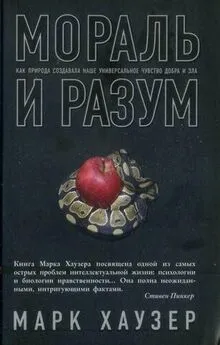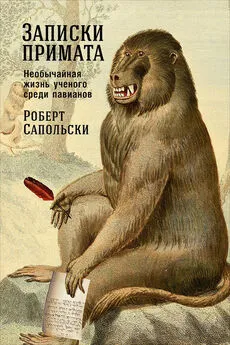Роберт Сапольски - Биология добра и зла. Как наука объясняет наши поступки
- Название:Биология добра и зла. Как наука объясняет наши поступки
- Автор:
- Жанр:
- Издательство:Альпина нон-фикшн
- Год:2019
- Город:Москва
- ISBN:978-5-0013-9051-0
- Рейтинг:
- Избранное:Добавить в избранное
-
Отзывы:
-
Ваша оценка:
Роберт Сапольски - Биология добра и зла. Как наука объясняет наши поступки краткое содержание
Биология добра и зла. Как наука объясняет наши поступки - читать онлайн бесплатно ознакомительный отрывок
Интервал:
Закладка:
41
P. Janak and K. Tye, “From Circuits to Behavior in the Amygdala,” Nat 517 (2015): 284.
42
J. LeDoux, “Coming to Terms with Fear,” PNAS 111 (2014): 2871; J. LeDoux, “The Amygdala,” Curr Biol 17 (2007): R868; K. Tully et al., “Norepinephrine Enables the Induction of Associative LTP at Thalamo-Amygdala Synapses,” PNAS 104 (2007): 14146.
43
T. Rizvi et al., “Connections Between the Central Nucleus of the Amygdala and the Midbrain Periaqueductal Gray: Topography and Reciprocity,” J Comp Neurol 303 (1991): 121; E. Kim et al., “Dorsal Periaqueductal Gray-Amygdala Pathway Conveys Both Innate and Learned Fear Responses in Rats,” PNAS 110 (2013): 14795; C.Del-Ben and F. Graeff, “Panic Disorder: Is the PAG Involved?” Neural Plasticity 2009 (2009): 108135; P. Petrovic et al., “Context Dependent Amygdala Deactivation During Pain,” Neuroimage 13 (2001): S457; J. Johnson et al., “Neural Substrates for Expectation-Modulated Fear Learning in the Amygdala and Periaqueductal Gray,” Nat Nsci 13 (2010): 979; W. Yoshida et al., “Uncertainty Increases Pain: Evidence for a Novel Mechanism of Pain Modulation Involving the Periaqueductal Gray,” J Nsci 33 (2013): 5638.
44
T. Heatherton, “Neuroscience of Self and Self-Regulation,” Ann Rev of Psych 62 (2011): 363; K. Krendl et al., “The Good, the Bad, and the Ugly: An fMRI Investigation of the Functional Anatomic Correlates of Stigma,” Soc Nsci 1 (2006): 5; F. Sambataro et al., “Preferential Responses in Amygdala and Insula During Presentation of Facial Contempt and Disgust,” Eur J Nsci 24, (2006): 2355.
45
X. Liu et al., “Optogenetic Stimulation of a Hippocampal Engram Activates Fear Memory Recall,” Nat 484 (2012): 381; T. Seidenbecher et al., “Amygdalar and Hippocampal Theta Rhythm Synchronization During Fear Memory Retrieval,” Sci 301 (2003): 846; R. Redondo et al., “Bidirectional Switch of the Valence Associated with a Hippocampal Contextual Memory Engram,” Nat 513 (2014): 426; E. Kirby et al., “Basolateral Amygdala Regulation of Adult Hippocampal Neurogenesis and Fear-Related Activation of Newborn Neurons,” Mol Psychiatry 17 (2012): 527.
46
A. Gozzi, “A Neural Switch for Active and Passive Fear,” Neuron 67 (2010): 656.
47
G. Aston-Jones and J. Cohen, “Adaptive Gain and the Role of the Locus Coeruleus-Norepinephrine System in Optimal Performance,” J Comp Neurol 493 (2005): 99; M. Carter et al., “Tuning Arousal with Optogenetic Modulation of Locus Coeruleus Neurons,” Nat Nsci 13 (2010): 1526.
48
D. Blanchard et al., “Lesions of Structures Showing FOS Expression to Cat Presentation: Effects on Responsivity to a Cat, Cat Odor, and Nonpredator Threat,” Nsci Biobehav Rev 29 (2005): 1243.
49
G. Holstege, “Brain Activation During Human Male Ejaculation,” J Nsci 23 (2003): 9185; H. Lee et al., “Scalable Control of Mounting and Attack by Ers1+ Neurons in the Ventromedial Hypothalamus,” Nat 509 (2014): 627; D. Anderson, “Optogenetics, Sex, and Violence in the Brain: Implications for Psychiatry,” BP 71 (2012): 1081.
50
K Blair, “Neuroimaging of Psychopathy and Antisocial Behavior: A Targeted Review,” Curr Psychiatry Rep 12 (2010): 76; K. Kiehl, The Psychopath Whisperer: The Nature of Those Without Conscience (Woodland Hills, CA: Crown Books, 2014); M. Koenigs et al., “Investigating the Neural Correlates of Psychopathy: A Critical Review,” Mol Psychiatry 16 (2011): 792.
51
Здесь весьма интересные рассуждения об импульсивности лобной коры: J. Dalley et al., “Impulsivity, Compulsivity, and Top-Down Cognitive Control,” Neuron 69 (2011): 680.
52
J. Rilling and T. Insel, “The Primate Neocortex in Comparative Perspective Using MRI,” J Hum Evol 37 (1999): 191; R. Barton and C. Venditti, “Human Frontal Lobes Are Not Relatively Large,” PNAS 110 (2013): 9001; Y. Zhang et al., “Accelerated Recruitment of New Brain Development Genes into the Human Genome,” PLoS Biol 9 (2011): e1001179; G. Miller, “New Clues About What Makes the Human Brain Special,” Sci 330 (2010): 1167; K. Semendeferi et al., “Humans and Great Apes Share a Large Frontal Cortex,” Nat Nsci 5 (2002): 272; P. Schoenemann, “Evolution of the Size and Functional Areas of the Human Brain,” Ann Rev of Anthropology 35 (2006): 379.
53
J. Allman et al., “The von Economo Neurons in the Frontoinsular and Anterior Cingulate Cortex,” ANYAS 1225 (2011): 59; C. Butti et al., “Von Economo Neurons: Clinical and Evolutionary Perspectives,” Cortex 49 (2013): 312; H. Evrard et al., “Von Economo Neurons in the Anterior Insula of the Macaque Monkey,” Neuron 74 (2012): 482.
54
E. Miller and J. Cohen, “An Integrative Theory of Prefrontal Cortex Function,” Ann Rev of Nsci 24 (2001): 167.
55
V. Mante et al., “Context-Dependent Computation by Recurrent Dynamics in Prefrontal Cortex,” Nat 503 (2013): 78. Вот еще несколько публикаций, где обсуждается вовлечение лобной коры, когда требуется переключиться на другую задачу: S. Bunge, “How We Use Rules to Select Actions: A Review of Evidence from Cognitive Neuroscience,” SCAN 4 (2004): 564; E. Crone et al., “Evidence for Separable Neural Processes Underlying Flexible Rule Use,” Cerebral Cortex 16 (2005): 475; R. Passingham et al., “Specialisation Within the Prefrontal Cortex: The Ventral Prefrontal Cortex and Associative Learning,” Exp Brain Res 133 (2000): 103; D. Liu et al., “Medial Prefrontal Activity During Delay Period Contributes to Learning of a Working Memory Task,” Sci 346 (2014): 458.
56
J. Baldo et al., “Memory Performance on the California Verbal Learning Test-II: Findings from Patients with Focal Frontal Lesions,” J the Int Neuropsychological Soc 8 (2002): 539.
57
D. Freedman, “Categorical Representation of Visual Stimuli in the Primate Prefrontal Cortex,” Sci 291 (2001): 312. Еще примеры кодировки разных категорий: D. McNamee et al., “Category-Dependent and Category-Independent Goal-Value Codes in Human Ventromedial Prefrontal Cortex,” Nat Nsci 16 (2013): 479. R. Schmidt et al., “Canceling Actions Involves a Race Between Basal Ganglia Pathways,” Nat Nsci 16 (2013): 1118.
58
M. Histed et al., “Learning Subtracts in the Primate Prefrontal Cortex and Striatum: Sustained Activity Related to Successful Actions,” Neuron 63 (2004): 244. Вот еще несколько хороших примеров того, как лобная кора продолжает придерживаться выбранной линии: D. Crowe et al., “Prefrontal Neurons Transmit Signals to Parietal Neurons That Reflect Executive Control of Cognition,” Nat Nsci 16 (2013): 1484.
59
M. Rigotti et al., “The Importance of Mixed Selectivity in Complex Cognitive Tasks,” Nat 497 (2013): 585; J. Cromer et al., “Representation of Multiple, Independent Categories in the Primate Prefrontal Cortex,” Neuron 66 (2010): 796; M. Cole et al., “Global Connectivity of Prefrontal Cortex Predicts Cognitive Control and Intelligence,” J Nsci 32 (2012): 8988.
60
L. Grossman et al., “Accelerated Evolution of the Electron Transport Chain in Anthropoid Primates,” Trends in Genetics 20 (2004): 578.
61
J. W. De Fockert et al., “The Role of Working Memory in Visual Selective Attention,” Sci 291 (2001): 1803; K. Vohs et al., “Making Choices Impairs Subsequent Self-Control: A Limited-Resource Account of Decision Making, Self-Regulation, and Active Initiative,” JPSP 94 (2008): 883; K. Watanabe and S. Funahashi, “Neural Mechanisms of Dual-Task Interference and Cognitive Capacity Limitation in the Prefrontal Cortex,” Nat Nsci 17 (2014): 601.
62
N. Meand et al., “Too Tired to Tell the Truth: Self-Control Resource Depletion and Dishonesty,” JESP 45 (2009): 594; M. Hagger et al., “Ego Depletion and the Strength Model of Self-Control: A Meta-analysis,” Psych Bull 136 (2010): 495; C. DeWall et al., “Depletion Makes the Heart Grow Less Helpful: Helping as a Function of Self-Regulatory Energy and Genetic Relatedness,” PSPB 34 (2008): 1653; W. Hofmann et al., “And Deplete Us Not into Temptation: Automatic Attitudes, Dietary Restraint, and Self-Regulatory Resources as Determinants of Eating Behavior,” JESP 43 (2007): 497.
63
К сноске: M. Inzlicht and S. Marcora, “The Central Governor Model of Exercise Regulation Teaches Us Precious Little About the Nature of Mental Fatigue and Self-Control Failure,” Front Psych 7 (2016): 656.
64
J. Fuster, “The Prefrontal Cortex – an Update: Time Is of the Essence,” Neuron 30 (2001): 319.
65
K. Yoshida et al., “Social Error Monitoring in Macaque Frontal Cortex,” Nat Nsci 15 (2012): 1307; T. Behrens et al., “Associative Learning of Social Value,” Nat 456 (2008): 245.
66
R. Dunbar, “The Social Brain Meets Neuroimaging,” TICS 16 (2011): 101; K. Bickart et al., “Intrinsic Amygdala-Cortical Functional Connectivity Predicts Social Network Size in Humans” J Nsci 32 (2012): 14729; K. Bickart, “Amygdala Volume and Social Network Size in Humans,” Nat Nsci 14 (2010): 163; R. Kanai et al., “Online Social Network Size Is Reflected in Human Brain Structure,” Proc Royal Soc B 279 (2012): 1327; F. Amici et al., “Fission-Fusion Dynamics, Behavioral Flexibility, and Inhibitory Control in Primates,” Curr Biol 18 (2008): 1415. О подобных находках у врановых см.: A. Bond et al., “Serial Reversal Learning and the Evolution of Behavioral Flexibility in Three Species of North American Corvids ( Gymnorhinus cyanocephalus, Nucifraga columbiana, Aphelocoma californica ),” JCP 121 (2007): 372.
67
P. Lewis et al., “Ventromedial Prefrontal Volume Predicts Understanding of Others and Social Network Size,” Neuroimage 57 (2011): 1624; J. Sallet et al., “Social Network Size Affects Neural Circuits in Macaques,” Sci 334 (2011): 697.
68
J. Harlow, “Recovery from the Passage of an Iron Bar Through the Head,” Publication of the Massachusetts Med Soc 2 (1868): 327; H. Damasio et al., “The Return of Phineas Gage: Clues About the Brain from the Skull of a Famous Patient,” Sci 264 (1994): 1102; P. Ratiu and I. Talos, “The Tale of Phineas Gage, Digitally Remastered,” NEJM 351 (2004): e21; J. Van Horn et al., “Mapping Connectivity Damage in the Case of Phineas Gage,” PLoS ONE 7 (2012): e37454; M. Macmillan, An Odd Kind of Fame: Stories of Phineas Gage (Cambridge, MA: MIT Press, 2000); J. Jackson, “Frontis. and Nos. 949–51,” in A Descriptive Catalog of the Warren Anatomical Museum , reproduced in Macmillan, An Odd Kind of Fame . The photographs of Gage come from J. Wilgus and B. Wilgus, “Face to Face with Phineas Gage,” J the History of the Nsci 18 (2009): 340.
Читать дальшеИнтервал:
Закладка:





![Роберт Сапольски - Игры тестостерона и другие вопросы биологии поведения [litres]](/books/1074102/robert-sapolski-igry-testosterona-i-drugie-vopros.webp)




